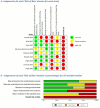Teleintervention's effects on breastfeeding in low-income women in high income countries: a systematic review and meta-analysis
- PMID: 38615079
- PMCID: PMC11015560
- DOI: 10.1186/s13006-024-00631-2
Teleintervention's effects on breastfeeding in low-income women in high income countries: a systematic review and meta-analysis
Abstract
Background: Many mothers in high-income countries (HIC) do not breastfeed to the World Health Organisation's recommendation of two years. This is particularly true for low-income women (LIW). They often face additional socio-structural barriers that encourage early discontinuation and are inadequately supported by current healthcare interventions. Teleinterventions are flexible and widely used following the global pandemic and increase maternal autonomy over intervention delivery. They show promise in improving other maternal conditions in LIW, including postpartum depression. Teleinterventions can increase breastfeeding rates in the wider maternal population, however their efficacy for this underserved population has not yet been systematically assessed. This meta-analysis aimed to identify if teleinterventions increase 'exclusive' or 'any' breastfeeding by LIW in HIC at 1-, 3-4, and 6-months postpartum.
Methods: We searched five online databases for randomised controlled trials assessing breastfeeding teleinterventions for LIW in HIC. Risk ratios (RR) were used to calculate the average effect of teleinterventions on 'any' and 'exclusive' breastfeeding at at 1-, 3-4, and 6-months postpartum using random effects meta-analysis. Study bias was assessed using the Revised Cochrane risk-of-bias tool for randomised trials (RoB2), and outcome quality was evaluated against GRADE criteria.
Results: Nine studies met inclusion criteria: six providing telephone calls, two text messages and one an online support group. All the studies were conducted in the United States, with small sample sizes and a high risk of bias. Pooled results indicate teleinterventions modestly increase 'any' and 'exclusive' breastfeeding at all time points, with a statistically significant increase in 'exclusive' breastfeeding after 3-4 months (RR 1.12, 95% CI [1.00,1.25]). At 3-4 months teleinterventions providing peer support were more effective than educational teleinterventions at promoting any and exclusive breastfeeding. Evidence for all outcomes were rated 'low' or 'very low' quality using the GRADE tool, mainly due to high attrition and low power.
Conclusions: Despite insufficient high-quality research into breastfeeding teleinterventions for LIW, our results suggest teleinterventions may improve exclusive and any breastfeeding. Given breastfeeding is particularly low in LIW population from HIC, our findings are promising and require further exploration by larger, methodologically sound trials in other HIC.
© 2024. The Author(s).
Conflict of interest statement
The authors declare no competing interests.
Figures
Similar articles
-
Support for healthy breastfeeding mothers with healthy term babies.Cochrane Database Syst Rev. 2022 Oct 25;10(10):CD001141. doi: 10.1002/14651858.CD001141.pub6. Cochrane Database Syst Rev. 2022. PMID: 36282618 Free PMC article.
-
Breastfeeding interventions for preventing postpartum depression.Cochrane Database Syst Rev. 2025 Feb 18;2(2):CD014833. doi: 10.1002/14651858.CD014833.pub2. Cochrane Database Syst Rev. 2025. PMID: 39963955
-
Antenatal breastfeeding education for increasing breastfeeding duration.Cochrane Database Syst Rev. 2016 Dec 6;12(12):CD006425. doi: 10.1002/14651858.CD006425.pub4. Cochrane Database Syst Rev. 2016. PMID: 27922724 Free PMC article.
-
Early additional food and fluids for healthy breastfed full-term infants.Cochrane Database Syst Rev. 2016 Aug 30;2016(8):CD006462. doi: 10.1002/14651858.CD006462.pub4. Cochrane Database Syst Rev. 2016. PMID: 27574798 Free PMC article.
-
Support for healthy breastfeeding mothers with healthy term babies.Cochrane Database Syst Rev. 2017 Feb 28;2(2):CD001141. doi: 10.1002/14651858.CD001141.pub5. Cochrane Database Syst Rev. 2017. Update in: Cochrane Database Syst Rev. 2022 Oct 25;10:CD001141. doi: 10.1002/14651858.CD001141.pub6. PMID: 28244064 Free PMC article. Updated.
References
-
- Public Health England. Child and Maternal Health - PHE [Internet]. Public Health Engl. Profiles. 2020 [cited 2020 Nov 9]. Available from: https://fingertips.phe.org.uk/profile/child-health-profiles/data#page/0/....
-
- Fair FJ, Ford GL, Soltani H. Interventions for supporting the initiation and continuation of breastfeeding among women who are overweight or obese. Cochrane Database Syst Rev [Internet]. 2019 [cited 2021 Feb 21];2019. Available from: https://www.ncbi.nlm.nih.gov/pmc/articles/PMC6747740/. - PMC - PubMed
Publication types
MeSH terms
LinkOut - more resources
Full Text Sources
Medical
Miscellaneous





